
Bluetooth is a short-range wireless technology standard that is used for exchanging data between fixed and mobile devices over short distances and building personal area networks (PANs). In the most widely used mode, transmission power is limited to 2.5 milliwatts, giving it a very short range of up to 10 metres (33 ft). It employs UHF radio waves in the ISM bands, from 2.402 GHz to 2.48 GHz. It is mainly used as an alternative to wired connections to exchange files between nearby portable devices and connect cell phones and music players with wireless headphones.
Ultra-wideband is a radio technology that can use a very low energy level for short-range, high-bandwidth communications over a large portion of the radio spectrum. UWB has traditional applications in non-cooperative radar imaging. Most recent applications target sensor data collection, precise locating, and tracking. UWB support started to appear in high-end smartphones in 2019.

Near-field communication (NFC) is a set of communication protocols that enables communication between two electronic devices over a distance of 4 centimetres (1.6 in) or less. NFC offers a low-speed connection through a simple setup that can be used for the bootstrapping of capable wireless connections. Like other proximity card technologies, NFC is based on inductive coupling between two electromagnetic coils present on a NFC-enabled device such as a smartphone. NFC communicating in one or both directions uses a frequency of 13.56 MHz in the globally available unlicensed radio frequency ISM band, compliant with the ISO/IEC 18000-3 air interface standard at data rates ranging from 106 to 848 kbit/s.
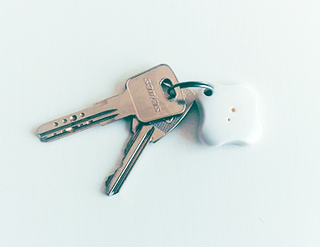
Key finders, also known as keyfinders, key locators, or electronic finders, are small electronic devices fitted to objects to locate them when misplaced or stolen, such as keys, luggage, purses, wallets, pets, laptop computers, toddlers, cellphones, equipment, or tools, and to transmit alerts, e.g., that one's restaurant table is ready or a nurse is needed. Some key finders beep or flash lights on demand.

A smartwatch is a portable and wearable computer device in a form of a watch; modern smartwatches provide a local touchscreen interface for daily use, while an associated smartphone app provides management and telemetry, such as long-term biomonitoring. While early models could perform basic tasks such as calculations, digital time telling, translations, and game-playing, smartwatches released since 2015 have more general functionality closer to smartphones, including mobile apps, a mobile operating system, and WiFi/Bluetooth connectivity. Some smartwatches function as portable media players, with FM radio and playback of digital audio and video files via a Bluetooth headset. Some models, called watch phones, have mobile cellular functionality such as making telephone calls.

S Pen (Korean: S펜) is a wireless digital pen stylus designed and developed by Samsung Electronics featuring Wacom's digital pen technology. It is made for use with supported Galaxy mobile devices like smartphones and tablets, as well as selected Samsung Notebook, Samsung Galaxy Book, and Chromebook notebooks. It was first released with the Samsung Galaxy Note series in 2011, becoming a core feature of the Note line of products. The S Pen supports features such as translating text by hovering the pen, and creating animated messages.
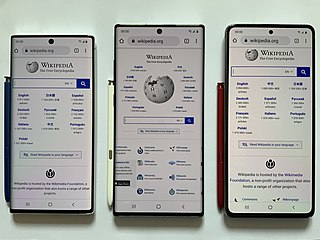
A phablet is a mobile device combining or straddling the size formats of smartphones and tablets. The word is a portmanteau of phone and tablet. The term is largely obsolete by the late 2010s, since average smartphone sizes eventually morphed into small tablet sizes, up to 6.9 inches (180 mm), with wider aspect ratios.

The Samsung Galaxy S series is a line of flagship Android smartphone and tablet computer produced by Samsung Electronics. In conjunction with the foldable Galaxy Z series, the lineup serves as Samsung's flagship smartphone lineup.

The Samsung Galaxy Note series was a line of high-end flagship Android phablets and smartphones developed and marketed by Samsung Electronics. The line is primarily oriented towards pen computing; all Galaxy Note models shipped with a stylus pen, called the S Pen, and incorporate a pressure-sensitive Wacom digitizer. All Galaxy Note models also include software features that are oriented towards the stylus and the devices' large screens, such as note-taking, digital scrapbooking apps, tooltips, and split-screen multitasking. The line served as Samsung's flagship smartphone model, positioned above the Galaxy S series.

Tile is an American consumer electronics company which produces tracking devices that users can attach to their belongings such as keys and backpacks. A companion mobile app for Android and iOS allows users to track the devices using Bluetooth 4.0 in order to locate lost items or to view their last detected location. The first devices were delivered in 2013. In September 2015, Tile launched a newer line of hardware that includes functionality to assist users in locating smartphones, as well as other feature upgrades. In August 2017, two new versions of the Tile were launched, the Tile Sport and Tile Style. As of 2019, Tile's hardware offerings consist of the Pro, Mate, Slim, and Sticker.

The Samsung Galaxy Gear is a smartwatch produced by Samsung Electronics in the Samsung Gear family of devices. Unveiled during a Samsung Unpacked event in Berlin, Germany on September 4, 2013, the device serves as a companion for all Samsung Galaxy smartphones and tablets which runs on Android 4.3 "Jelly Bean" or newer. It was released on September 25, 2013. Originally released as an Android-based device, Samsung replaced the operating system with Tizen through the May 2014 software update.
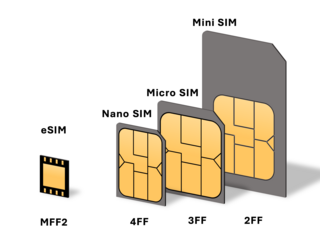
An eSIM (embedded-SIM) is a form of SIM card that is embedded directly into a device. Instead of an integrated circuit located on a removable SIM card, typically made of PVC, an eSIM consists of software installed onto an eUICC chip permanently attached to a device. If the eSIM is eUICC-compatible, it can be re-programmed with new SIM information. Otherwise, the eSIM is programmed with its ICCID/IMSI and other information at the time it is manufactured, and cannot be changed. Different mobile telephones may not support an eSIM, may have a permanently programmed, unchangeable one, or one that can be reprogrammed for any carrier that supports the technology. Phones may support physical SIMs only, eSIM only, or both.

Bixby is a virtual assistant developed by Samsung Electronics, launched in 2017 as a replacement of the S Voice assistant. It runs on various Samsung branded appliances, primarily mobile devices but also some refrigerators. The suite includes a voice assistant known as Bixby Voice, as well as contextual search and visual search features including tools like Bixby Vision, an augmented reality camera app, Bixby Text Call, a handsfree call answer feature, and others like Bixby Routines, and Bixby Home.
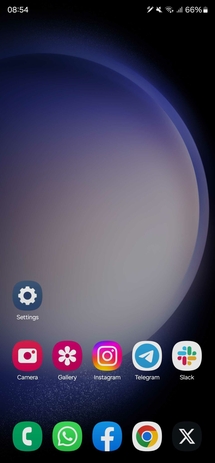
One UI is a user interface (UI) developed by Samsung Electronics for its Android devices running Android 9 "Pie" and later. Succeeding Samsung Experience and TouchWiz, it is designed to make using larger smartphones easier and be more visually appealing. To provide more clarity, some elements of the UI are tweaked to match colors that are based on the color of the user's phone. It was announced at Samsung Developer Conference in 2018, and was unveiled in Galaxy Unpacked in February 2019 alongside the Galaxy S10 series, Galaxy Buds and the Galaxy Fold.
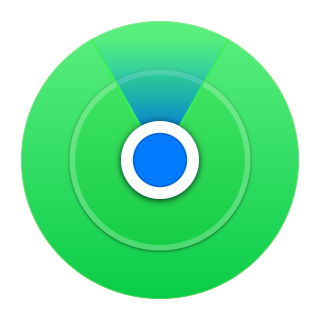
Find My is an asset tracking service made by Apple Inc. that enables users to track the location of iOS, iPadOS, macOS, watchOS devices, AirPods, AirTags and a number of supported third-party accessories through a connected iCloud account. Users can also share their GPS locations to others with Apple devices and view the location of others who choose to share their location. Find My was released alongside iOS 13 on September 19, 2019, merging the functions of the former Find My iPhone and Find My Friends into a single app. On watchOS, Find My is separated into three different applications: Find Devices, Find People and Find Items.

The Samsung Galaxy S20 is a series of Android-based smartphones designed, developed, manufactured, and marketed by Samsung Electronics as part of its Galaxy S series. They collectively serve as the successor to the Galaxy S10 series. The first three smartphones were unveiled at Samsung's Galaxy Unpacked event on 11 February 2020 while the Fan Edition model was unveiled at Samsung's Galaxy Unpacked event on 23 September 2020.

AirTag is a tracking device developed by Apple. AirTag is designed to act as a key finder, which helps people find personal objects. To locate lost items, AirTags use Apple's crowdsourced Find My network, estimated in early 2021 to consist of approximately one billion devices worldwide that detect and anonymously report emitted Bluetooth signals. AirTags are compatible with any iPhone, iPad, or iPod Touch device capable of running iOS/iPadOS 14.5 or later, including iPhone 6S or later. Using the built-in U1 chip on iPhone 11 or later, users can more precisely locate items using ultra-wideband (UWB) technology. AirTag was announced on April 20, 2021, made available for pre-order on April 23, and released on April 30.

The Samsung Galaxy S21 is a series of high-end Android-based smartphones designed, developed, marketed, and manufactured by Samsung Electronics as part of its Galaxy S series. They collectively serve as the successor to the Samsung Galaxy S20 series. The first three smartphones were unveiled at Samsung's Galaxy Unpacked event on 14 January 2021, while the Fan Edition model was unveiled at Samsung's CES on 3 January 2022.

The Samsung Galaxy S22 is a series of Android-based smartphones designed, developed, manufactured, and marketed by Samsung Electronics as part of its Galaxy S series. Unveiled at Samsung's Galaxy Unpacked event on 9 February 2022.


















